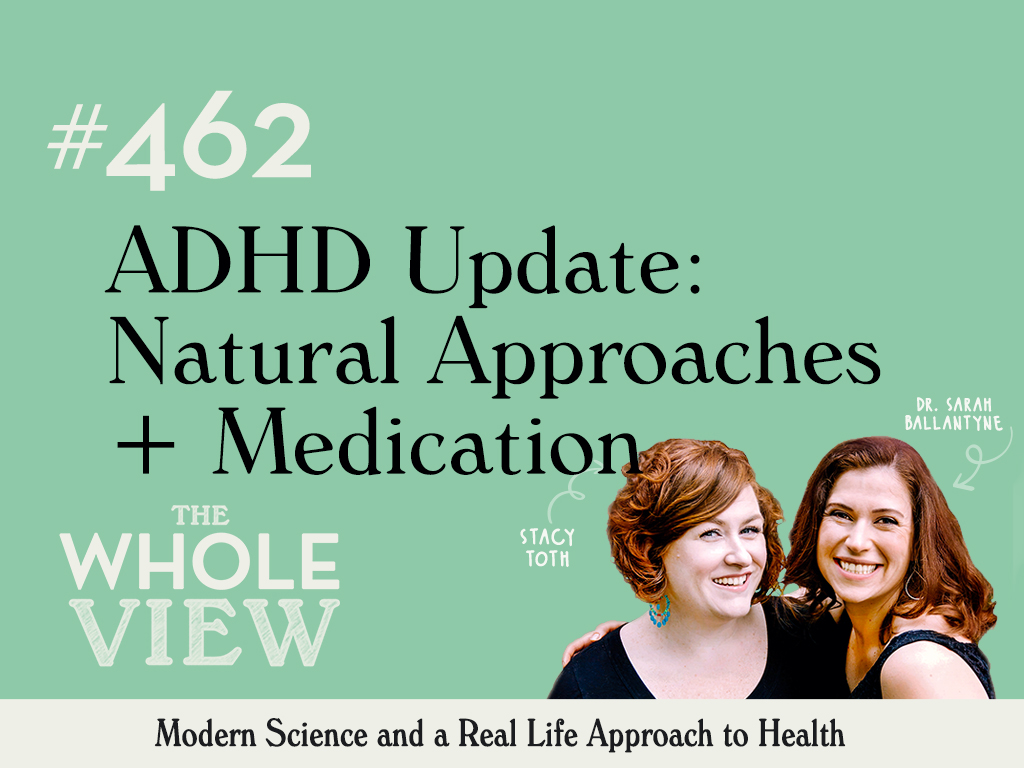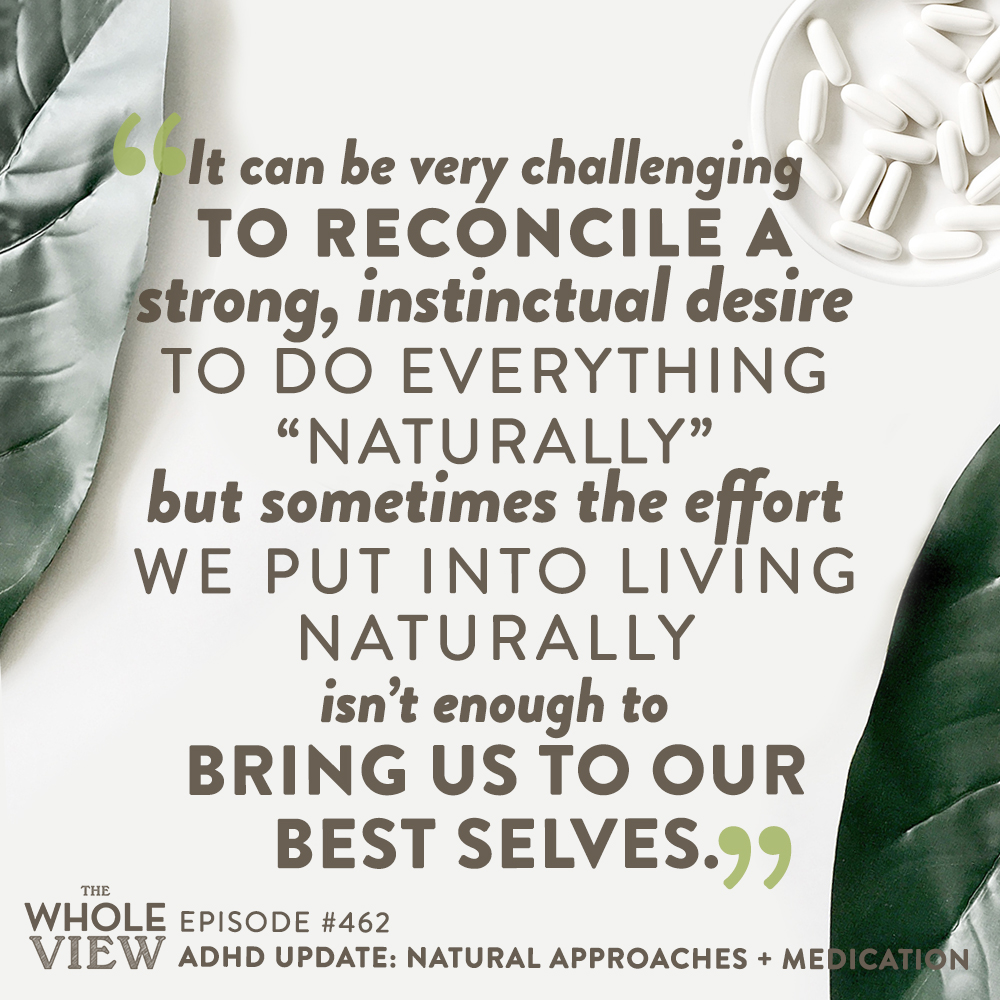
Welcome to episode 462 of The Whole View! This week, Sarah and Stacy revisit previous episodes on ADHD and update the science behind natural approaches and medication.
If you enjoy the show, please review it on iTunes!
The Whole View, Episode 462: ADHD Update: Natural Approaches and Medication
Welcome back to episode 462! (0:28)
Science is an evolutionary process, and things change as we learn and grow. Stacy and Sarah have years of content they want to bring to the forefront as relevant and update any information that might have since changed.
Stacy’s son Cole has inactive ADHD (previously called ADD), an attention deficit without the hyperactive traits associated with ADHD.
Because of the differences, Stacy’s family manages Cole’s ADHD is very different from how they manage her youngest’s, Westley’s, who has hyperactive traits.
Medication is not a failure. However, at the beginning of Stacy’s journey, she operated under the mindset that not medicating is better.
No matter how much you diet and exercise, it doesn’t change a medical condition. There is nothing wrong with utilizing medications to manage a medical condition, and it doesn’t mean you’ve failed yourself or your kids.
Stacy tried everything she could to manage Cole’s ADHD and admits she waited too long to try medicine.
Seeing her child less anxious, less angry, more attentive, and in control of himself made her grateful to have found a medication that worked for him. She also feels very strongly that it made her a better mother because she was helping him to be his best.
Stacy’s husband, Matt, was on a stimulant, and it worried her because of the long-term health risks. She wants to share updates with the audience and options she wishes she’d known sooner.
Sarah has the science, but Sarah and Stacy are not medical professionals. Be sure to consult with your doctor for what best for you.
For the notes on the prior shows, Stacy and Sarah revisit episodes 145 and 185.
Cole’s Update: One Year Later
Stacy’s oldest son, Cole, joins us once more to update us on ADHD and how he’s managing it in 2021. (1:17:50)
Cole makes his lunch every day to ensure he’s adhering to his dietary constraints. Cole’s teacher keeps a stock of gluten-free snacks in the classroom for Cole to have. And whenever it gets low, she lets Stacy know to restock it.
In terms of his ADHD, they’ve tried supplements and coffee for the caffeine content. Both did not work for Cole.
Cole has started walking to school to get rid of excess energy before his day starts. His teacher also allows him to work on his homework when there’s time in class.
When he’s not interested in a subject, it’s really difficult for him to remember what he learned about it. This comes from the inattentive side of his ADHD.
However, Cole is finding many more things that he enjoys and is overall happier than he was at the start of this journey.
Stacy and Cole found increasing his physical activity has been very helpful in managing his ADHD symptoms. She’s also noticed he’s been less physical with roughhousing with his brothers.
Managing Screen Time
Every week, Cole gets 1 hour of video game time as long as he doesn’t abuse it and he’s had a good week. (1:37:20)
It’s also limited to computer games and not console games. Stacy has noticed overstimulation from console games that she doesn’t see when he plays on the computer.
Overall, Cole’s attitude, mood, and more have drastically improved since he podcasted with Stacy and Sarah.
One of the best things Stacy had done was experimenting with lifestyle changes, such as monitoring screen time.
Sarah loves how Stacy’s approach has been very intuitive and adapted depending on how Cole’s body reacts.
Parenting for Stacy has been all about intuition, and they do a lot of alternative things, such as allowing the kids to curse at home.
ADHD Update: Natural Approaches and Medication for ADHD
Jumping back to the present day, Stacy explains how much working with a medical professional has helped her, Cole, and Westley on this journey. (1:51:00)
She’s so happy to have found a medication that worked for them and helped alleviate the symptoms of ADHD outside of inattention.
Stacy equates this to epilepsy: you can try lifestyle changes to help alleviate the symptoms, but if your child is still having seizures, you should also seek medical help.
The same philosophy can and should be applied with other cognitive conditions like ADHD.
Stacy learned that there’s a non-stimulant option and that it’s worked very well.
Central nervous system (CNS) stimulants are the most commonly prescribed ADHD medications. These drugs work by increasing the amounts of the brain chemicals dopamine and norepinephrine.
Examples of these drugs include methylphenidate (Ritalin) and amphetamine-based stimulants (Adderall).
Stimulants have been used to treat ADHD for several decades for their ability to help you focus and ignore distractions.
Stimulant meds work for 70% to 80% of people and treat moderate and severe ADHD. They also may be helpful for children, teens, and adults who have a hard time at school, work, or home.
Some stimulants are approved for use in children over age 3. Others are approved for children over age 6.
If stimulants don’t work or cause unpleasant side effects, your doctor may recommend a non-stimulant.
Certain non-stimulant medications work by increasing levels of norepinephrine in the brain.
These medications include atomoxetine (Strattera) and some antidepressants such as bupropion (Wellbutrin).
Natural Approaches and Medication: Stimulants
Stimulants are the most commonly prescribed medications for ADHD. They’re often the first course of drugs used for ADHD treatment.
You might hear this class of drugs called central nervous system (CNS) stimulant medications. They work by increasing the amounts of the hormones called dopamine and norepinephrine in the brain.
This effect improves concentration and decreases the fatigue that’s common with ADHD.
Amphetamines
Amphetamine, dextroamphetamine, and lisdexamfetamine are all stimulants used to treat ADHD.
They come in immediate-release and extended-release oral forms and can include brands such as:
- Adderall XR (generic available)
- Dexedrine (generic available)
- Dyanavel XR
- Evekeo
- ProCentra (generic available)
- Vyvanse
Methamphetamine
Methamphetamine is related to ephedrine and amphetamine and also works by stimulating the CNS. However, it’s not known exactly how this drug works to help ADHD symptoms.
Like other stimulants, methamphetamine may increase the amounts of hormones like dopamine and norepinephrine in your brain. It can also reduce your appetite and increase your blood pressure.
It comes as an oral tablet taken once or twice per day.
Methylphenidate
Methylphenidate works by blocking the reuptake of norepinephrine and dopamine in your brain to help increase levels of these hormones.
It comes in immediate-release, extended-release, and controlled-release oral forms. If oral doesn’t work for you, a transdermal patch under the brand name Daytrana is also available. Brands include:
- Aptensio XR (generic available)
- Metadate ER (generic available)
- Concerta (generic available)
- Daytrana
- Ritalin (generic available)
- Ritalin LA (generic available)
- Methylin (generic available)
- QuilliChew
- Quillivant
Dexmethylphenidate
Dexmethylphenidate is similar to methylphenidate and is available as the brand-name medication Focalin.
Side effects of short-acting stimulants include loss of appetite, weight loss, sleep problems, crankiness, and tics. Long-acting medicines may have greater effects on appetite and sleep.
The FDA warns about the risk of drug abuse with amphetamine stimulants. Safety advisers are also concerned that all amphetamine and methylphenidate stimulants used for ADHD may make heart and psychiatric problems more likely.
The risks associated with the long-term use of ADHD medication include:
- Heart disease
- High blood pressure
- Seizure
- Irregular heartbeat
- Abuse and addiction
- Skin discolorations
Natural Approaches and Medication: Non-stimulants
Non-stimulants affect the brain differently than stimulants do.
These drugs also affect neurotransmitters, but they don’t increase dopamine levels. So, it takes longer to see results from these drugs than from stimulants.
These drugs come in several classes, and a doctor might prescribe them when stimulants aren’t safe, ineffective, or avoid the side effects of stimulants.
Atomoxetine (Strattera)
Atomoxetine (Strattera) blocks the reuptake of norepinephrine in the brain, allowing it to work longer.
The drug comes in an oral form you take once or twice per day.
Atomoxetine has caused liver damage in a small number of people, so if you have signs of liver problems while taking this drug, your doctor will check your liver function.
Signs of liver problems include a tender or swollen abdomen, yellowing of your skin or the whites of your eyes, and fatigue.
Clonidine ER (Kapvay)
Clonidine ER (Kapvay) is used to reduce hyperactivity, impulsiveness, and distractibility in people with ADHD. Other forms of clonidine can treat high blood pressure.
Because it also lowers blood pressure, people taking it for ADHD may feel lightheaded.
Guanfacine ER (Intuniv)
Guanfacine is normally prescribed for high blood pressure in adults. Only the time-release version and its generics are approved for use in children with ADHD.
The time-release version is called Guanfacine ER (Intuniv). It may help with memory and behavioral problems, as well as improve aggression and hyperactivity.
Non-stimulant medications can take up to several weeks to start working. Also, they may not work as well as stimulants.
Some non-stimulant medications may raise the risk of suicidal thoughts and death by suicide in teens. This is why the FDA warns anyone taking atomoxetine (Strattera) is monitored for suicidal thoughts, especially during the first few weeks.
Common side effects of these drugs include fatigue, upset stomach, dry mouth, and nausea. Your blood pressure often rises when you stop taking them.
Final Thoughts on ADHD Natural Approaches and Medication
Stacy has found that the most effective way of handling ADHD symptoms is through natural approaches and medication. (2:02:00)
She chose a non-stimulant option because Cole didn’t need to dopamine increase that many people with ADHD benefit from. His focus was more on impulse control.
As a parent, if you’ve done everything you can from a lifestyle perspective, but you and your child are still not performing optimally, it’s okay to seek additional help with modern medicine.
Just know that it’s an effort you are making to help your child be their best self.
Be sure to hop over to Patreon to hear how Stacy and Sarah really feel about the topics they discuss. If you haven’t yet joined the Patreon family, your subscription helps to support this show and gets you direct access and bonus content.
Want more info on our Real Life? Healthy recipes, parenting tips, and general lifestyle stuff goes out in our Real Everything newsletter, join here.
Never want to miss a post, sale, or deal? Join my Healthy Inside & Out e-mail list for more info on non-toxic living and safer skincare!





